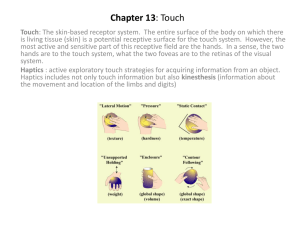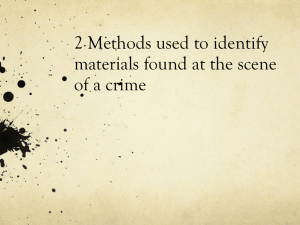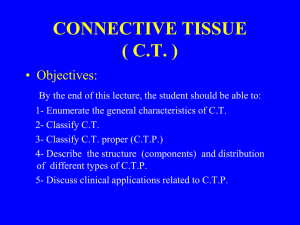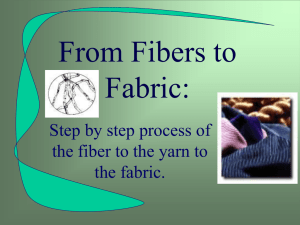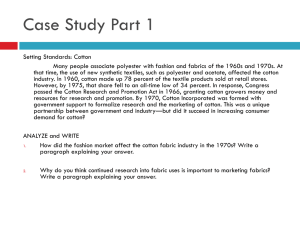Thursday Lecture – Fibers, Dyes and Tannins
advertisement
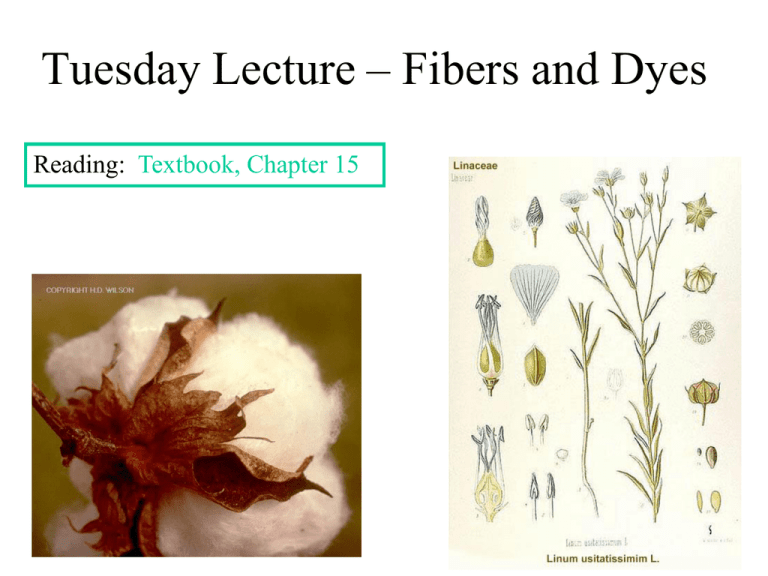
Tuesday Lecture – Fibers and Dyes Reading: Textbook, Chapter 15 Collect assignments – plant-derived chemicals added to food products Fibers - History Use of plant fibers seems to predate that of animal fibers Note: relatively few plants or animals produce fibers that can be woven or spun – use seems fairly recent Fig. 15.1, p. 556 Fibers - History Use of plant fibers seems to predate that of animal fibers Note: relatively few plants or animals produce fibers that can be woven or spun – use seems fairly recent 10,000 yrs ago – linen (from Linum) in Turkey Fig. 15.1, p. 556 Fibers - History Use of plant fibers seems to predate that of animal fibers Note: relatively few plants or animals produce fibers that can be woven or spun – use seems fairly recent 10,000 yrs ago – linen (from Linum) in Turkey 8,000 yrs ago – fiber sandals in Missouri Fig. 15.1, p. 556 Fibers - History Use of plant fibers seems to predate that of animal fibers Note: relatively few plants or animals produce fibers that can be woven or spun – use seems fairly recent 10,000 yrs ago – linen (from Linum) in Turkey 8,000 yrs ago – fiber sandals in Missouri 7,000 yrs ago – sheep domesticated Fig. 15.1, p. 556 Fibers - History Use of plant fibers seems to predate that of animal fibers Note: relatively few plants or animals produce fibers that can be woven or spun – use seems fairly recent 10,000 yrs ago – linen (from Linum) in Turkey 8,000 yrs ago – fiber sandals in Missouri 7,000 yrs ago – sheep domesticated 5,400 yrs ago – cotton fibers used in Mexico Fig. 15.1, p. 556 Fibers - History Use of plant fibers seems to predate that of animal fibers Note: relatively few plants or animals produce fibers that can be woven or spun – use seems fairly recent 10,000 yrs ago – linen (from Linum) in Turkey 8,000 yrs ago – fiber sandals in Missouri 7,000 yrs ago – sheep domesticated 5,400 yrs ago – cotton fibers used in Mexico 5,000 yrs ago – silk in Asia Fig. 15.1, p. 556 Plant vs. Animal Fibers Plant fibers: composed – partly - of cellulose - Animal fibers: composed of protein molecules Fig. 15.2, p. 557 Plant vs. Animal Fibers Plant fibers: composed – partly - of cellulose - can be heated - hard to dye - attacked by fungi, mold, termites - less elastic but more absorbent of water Animal fibers: composed of protein molecules - denatured by heat brittle - Fig. 15.2, p. 557 Plant vs. Animal Fibers Plant fibers: composed – partly - of cellulose - can be heated - hard to dye - attacked by fungi, mold, termites - less elastic but more absorbent of water Animal fibers: composed of protein molecules - denatured by heat brittle - readily accept dyes Fig. 15.2, p. 557 Plant vs. Animal Fibers Plant fibers: composed – partly - of cellulose - can be heated - hard to dye - attacked by fungi, mold, termites - less elastic but more absorbent of water Animal fibers: composed of protein molecules - denatured by heat brittle - readily accept dyes - attacked by moths, silverfish Fig. 15.2, p. 557 Plant vs. Animal Fibers Plant fibers: composed – partly - of cellulose - can be heated - hard to dye - attacked by fungi, mold, termites - less elastic but more absorbent of water Animal fibers: composed of protein molecules - denatured by heat brittle - readily accept dyes - attacked by moths, silverfish - more elastic, less absorbent of water Fig. 15.2, p. 557 Classification of Fibers Seed/Fruit Fibers – aid in seed dispersal - cotton, coir, kapok Bast Fibers – from phloem of stem - hemp, jute, ramie, linen Hard Fibers – from leaves of monocots - sisal, henequen, Manila hemp Material % Cellulose Cotton 98 Ramie 86 Hemp 65 Jute 58 Deciduous woods 41-42 Coniferous woods 41-44 Cornstalks 43 Wheat straw 42 Classification of Fibers Seed/Fruit Fibers – aid in seed dispersal - cotton, coir, kapok Bast Fibers – from phloem of stem - hemp, jute, ramie, linen Hard Fibers – from leaves of monocots - sisal, henequen, Manila hemp Material % Cellulose Cotton 98 Ramie 86 Hemp 65 Jute 58 Deciduous woods 41-42 Coniferous woods 41-44 Cornstalks 43 Wheat straw 42 Classification of Fibers Seed/Fruit Fibers – aid in seed dispersal - cotton, coir, kapok Bast Fibers – from phloem of stem - hemp, jute, ramie, linen Hard Fibers – from leaves of monocots - sisal, henequen, Manila hemp Material % Cellulose Cotton 98 Ramie 86 Hemp 65 Jute 58 Deciduous woods 41-42 Coniferous woods 41-44 Cornstalks 43 Wheat straw 42 Fiber Extraction Seed Fibers (Cotton) – actually trichomes, not fibers Ginning – separates fibers from seeds Mostly Bast Fibers: Retting – rots away non-fiber parts Scutching – beat and scraping retted plant material to remove broken pieces of woody matter Hackling – drawing a mass of fibers across pins to separate and align fibers Leaf Fibers Decorticating – crushing plant material and scraping away the nonfibrous material Fiber Extraction Seed Fibers (Cotton) – actually trichomes, not fibers Ginning – separates fibers from seeds Mostly Bast Fibers: Retting – rots away non-fiber parts Scutching – beat and scraping retted plant material to remove broken pieces of woody matter Hackling – drawing a mass of fibers across pins to separate and align fibers Leaf Fibers Decorticating – crushing plant material and scraping away the nonfibrous material Fiber Extraction Seed Fibers (Cotton) – actually trichomes, not fibers Ginning – separates fibers from seeds Mostly Bast Fibers: Retting – rots away non-fiber parts Scutching – beat and scraping retted plant material to remove broken pieces of woody matter Hackling – drawing a mass of fibers across pins to separate and align fibers Leaf Fibers Decorticating – crushing plant material and scraping away the nonfibrous material Seed Fibers - Cotton Fig. 15.7, p. 562 Cotton – Ancient History 4 independent domestications of cotton Fig. 15.9, p. 564 Problem: New World domesticates – have one genome present in wild only in Old World Possible resolution: AA genome predates continental separation G. arboreum G. hirsutum Tetraploids AADD G. barbadense G. herbaceum Diploids AA Cotton – Ancient History 4 independent domestications of cotton Fig. 15.9, p. 564 Problem: New World domesticates – have one genome present in wild only in Old World Possible resolution: AA genome predates continental separation G. arboreum G. hirsutum Tetraploids AADD G. barbadense G. herbaceum Diploids AA Cotton – Ancient History 4 independent domestications of cotton Fig. 15.9, p. 564 Problem: New World domesticates – have one genome present in wild only in Old World Possible resolution: AA genome predates continental separation G. arboreum G. hirsutum Tetraploids AADD G. barbadense G. herbaceum Diploids AA Cotton – More Recent History Hand Labor – Associated with Slavery in U.S. Cotton Gin – Enhanced Value Fig. 15.11, p. 565 Cotton - Spinning Cotton - Today Cotton – Issues: Chemical Use Irrigation Cotton Cloth - Details Cleaning – boiling in caustic soda, then treat with hydrogen peroxide removes pectins, waxes; lightens color of fibers Mercerizing (invented by J. Mercer) – soak thread or textile under pressure in caustic soda fibers swell, change shape Sizing – add starch or gel to thread, fills in irregularities, strengthens Sanforization – ammonia process, swells fibers and prevents shrinking Permanent press – use chemicals to cross-link cellulose polymers garment retains shape even after washing Dye Plants Paradox: We associate plants with beautiful colors, yet most plant pigments do not make good dyes Dye Plants Paradox: We associate plants with beautiful colors, yet most plant pigments do not make good dyes Resolution: Most plant pigments are chemically instable – when removed from the environment of the plant cell they are quickly degraded or washed away Dye Plants Paradox: We associate plants with beautiful colors, yet most plant pigments do not make good dyes Resolution: Most plant pigments are chemically instable – when removed from the environment of the plant cell they are quickly degraded or washed away Plant Dyes: - must be chemically stable (many oxidize when exposed to air) - must bind to object being dyed (=fastness) Mordant: chemical that increases adherence of dye to fabric - may also change color of dye Reminder This Thursday, April 21 – class will meet at UT Institute of Agriculture Gardens, next to the Vet School. Dress appropriately to be outside and take a garden tour.

